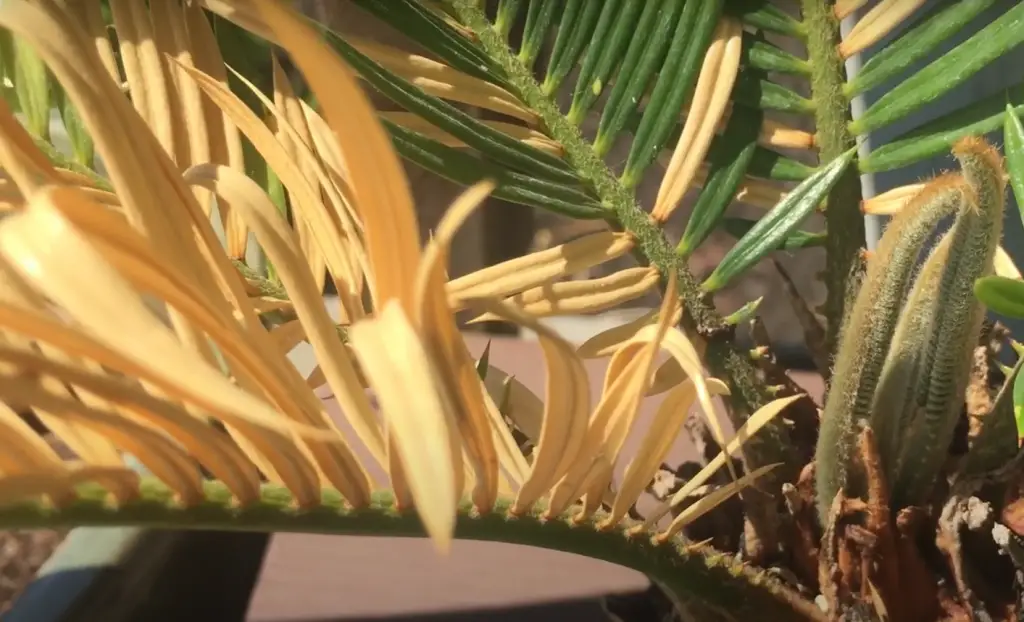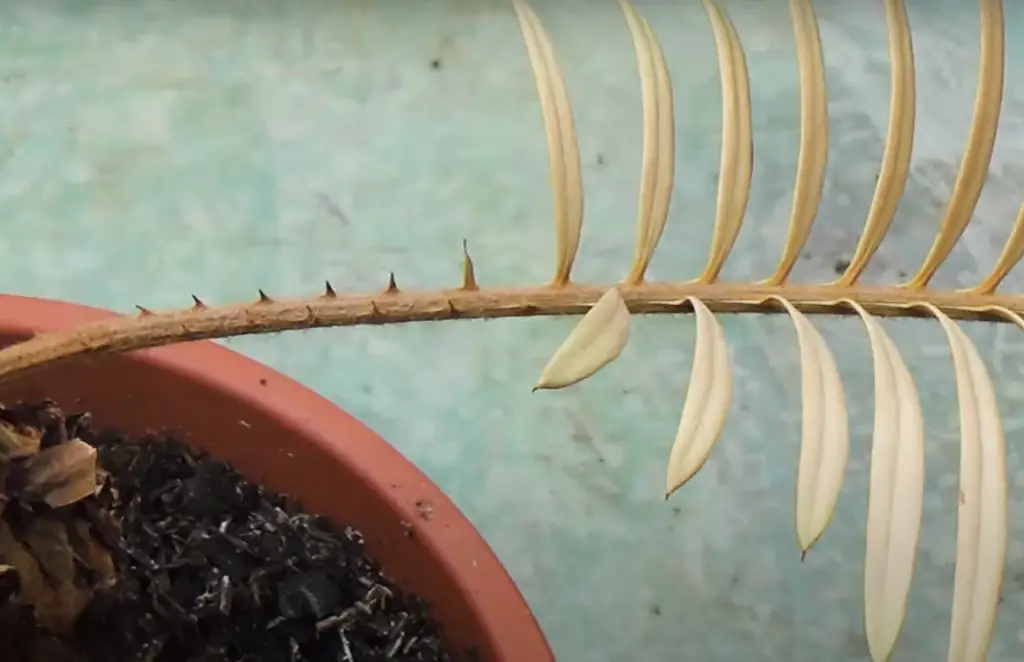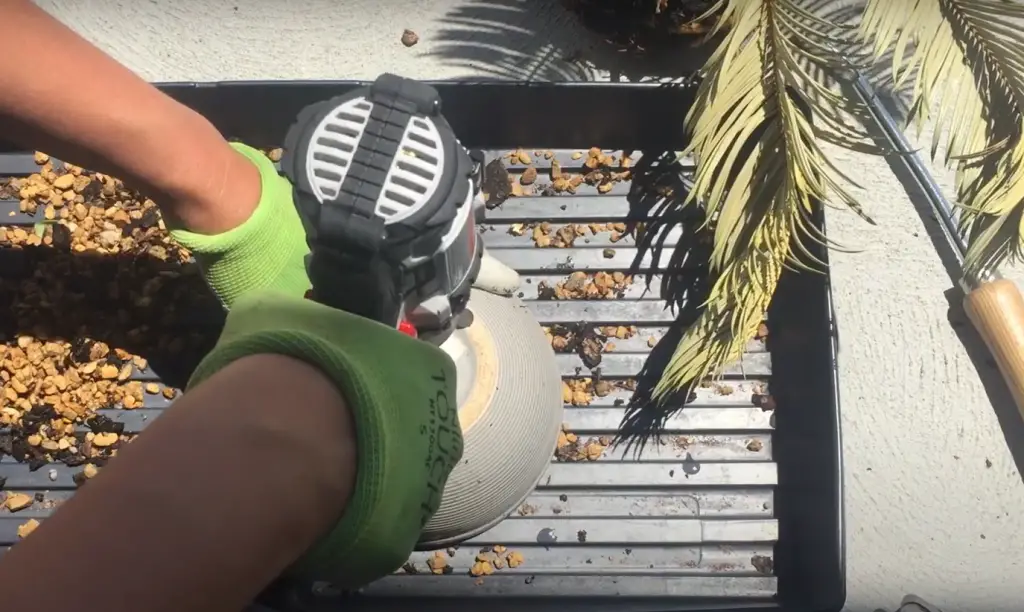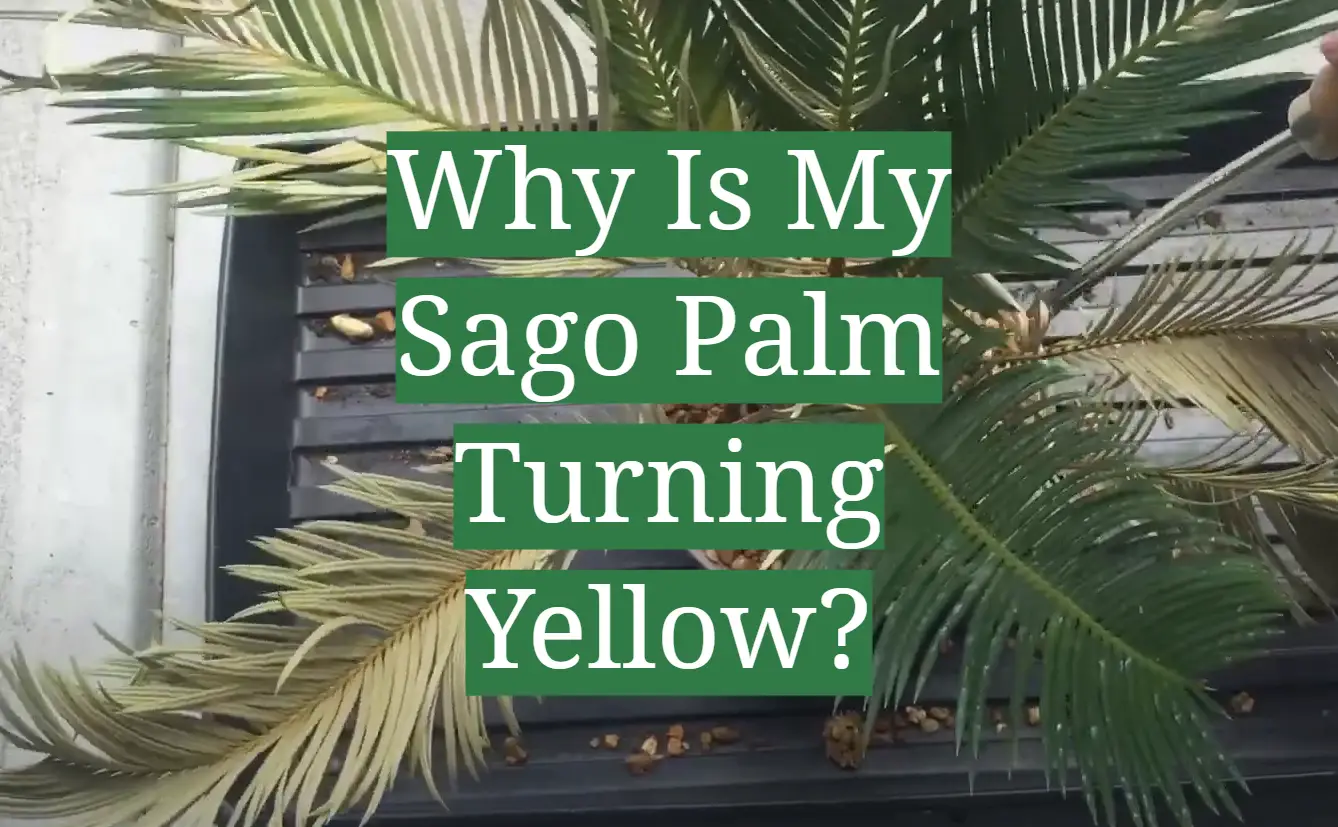Have you ever stood outside admiring your beautiful Sago Palm tree, only to come back the next day and spot some of its leaves have gone a sickly yellow? This can be an alarming sight for any plant enthusiast, but don’t worry – there are plenty of causes and solutions when it comes to discolouration in sago palms. Understanding a bit more about sago palm cultivation and disease prevention is key if you want to keep your beloved specimen thriving!
In this article we’ll explore the important features of sago palm growth, identify some common diseases that can affect these plants, and outline our approach for effective treatment. By maintaining the necessary steps for healthy growth from the very beginning of your journey with this superb ornamental plant – whether at business premises or residential gardens – you’ll stand a much better chance of reaping its long-term benefits.
What is Sago Palm?
Sago Palm is a tropical plant species that belongs to the family Cycadaceae. It is an evergreen perennial, with a stout trunk and large leaves.
Sago Palm produces edible seeds which are known as sago grains or pith, which are often used in cooking as an alternative to rice or flour.It also has many medicinal uses including treating nervous disorders, liver disease, fever and headaches. In addition, the entire plant is toxic if ingested in large amounts, so caution should be taken when handling it.
Sago palms are popular ornamental plants that add color and texture to any landscape design. They also make an excellent addition to any tropical garden. Sago palms are relatively easy to care for, requiring little more than water and fertilizer.

This palm is an ancient plant species with a long history of use by humans. It has been widely cultivated in tropical regions around the world for centuries, and it continues to be used today in a variety of ways. Whether you’re looking to add texture and color to your garden or interested in exploring this plant’s many medicinal benefits, sago is sure to make a great addition! [1]
How to Grow Sago Palm?
Sago palm is an attractive, slow-growing addition to any garden. It’s a great choice for borders, rock gardens and container gardening. Growing sago palm can be done either from seed or by division of existing plants, but it does require some special care in order to thrive. Here are a few tips on how to grow sago palm successfully:
- Planting – palms should be planted in well-draining soil that is slightly acidic, with a pH between 5 and 6.5 (you can buy a pH testing kit at your local nursery). The soil should also have plenty of organic matter such as compost or peat moss added to it before you plant the palm. When planting make sure its roots are covered by about an inch of soil.
- Watering – they prefer to stay consistently moist, but not soggy. During the summer months it’s best to water once a week, or more if you live in a particularly hot area. In winter, when the plant is dormant, you can water less frequently but make sure the soil still stays slightly damp.
- Fertilizer – palms don’t require a lot of fertilizer as they grow slowly and have low nutrient needs. Feed your palm annually with a slow-release fertilizer formulated for palms and cycads such as 8-4-12 or 10-3-10 fertilizers. Apply about 1/4 cup of fertilizer per gallon of soil in the spring. [2]
- Pruning – although sago palms are slow-growing, they can still benefit from occasional pruning to remove dead fronds or thin out the plant if it becomes too dense. Always use sharp, sterilized pruners and cut back to the base for a neat appearance.
- Protection – in colder climates, sago palms may need winter protection from frost damage. If temperatures dip below freezing, cover the plant with burlap or an old sheet and make sure it’s secured to the ground. You can also place a heated mat or blanket underneath the covering for added protection.
- Pests – they can be prone to scale insects, mealybugs and spider mites if not regularly inspected for pests. If you spot any signs of these pests on your sago palm, use an insecticidal soap or neem oil spray as soon as possible to avoid further damage to the plant. Regularly inspect the plant for any unwanted guests throughout the growing season and always follow label directions when using pesticides or other products around your sago palm. [3]
Is It Worth Planting a Palm Sago in Your Garden?
Planting a palm sago in your garden can bring numerous benefits. Not only are they incredibly beautiful, but they can also provide shade and privacy for many years to come. Plus, as an evergreen palm, they require minimal maintenance which makes them ideal for busy homeowners who don’t necessarily have the time or energy to devote to daily gardening tasks.
Palm sagos are also very hardy plants that can survive in a variety of climates. You won’t need to worry about extreme temperatures or intense weather conditions since these palms can tolerate both heat and cold with ease. Additionally, unlike other trees, their root systems won’t grow too large which means you won’t need to worry about them damaging your foundation or surrounding landscaping.
Finally, palm sagos can add a huge amount of character and charm to any garden. Whether you opt for a solitary specimen or create a grove of several palms, these trees will undoubtedly bring life and style to your outdoor space. With their unique shape and size, they’re sure to be the envy of all your neighbors! Planting one in your garden is sure to make it the envy of the neighborhood. [4]
What Diseases Can Affect Sago Palm Trees?
Sago palm trees are prone to several diseases, including Fusarium wilt, Ganoderma butt rot, Phytophthora root rot, and Cercospora leaf spot.

Fusarium wilt is a fungal disease that may cause yellowing of the leaves or patches of discolored tissue on the trunk. Ganoderma butt rot can cause bark splitting and stem collapse, while Phytophthora root rot causes dark lesions on the roots accompanied by wilting leaves. Cercospora leaf spot produces small tan spots or large brown blotches on the foliage, eventually turning the leaves yellow.
Other common pests include scale insects and mealybugs. Proper preventive measures such as proper sanitation and avoidance of over-irrigation can help protect sago palm trees from diseases and pests. Additionally, fungicidal drenches and insecticidal soaps may be used to treat existing infestations. Severe infections should be treated by a professional arborist or tree health specialist. [5]
How to Treat Sago Palm?
Once sago palms are affected with disease, it is important to treat them. Treatments vary depending on the type of disease affecting your plant. If you notice yellowing or wilting leaves, check for overwatering or underwatering:
- If you suspect root rot from overwatering, treat the sago palm by first removing any dead or dying roots and then repotting it in fresh, well-draining soil. Make sure that the pot is large enough so there is adequate space for new root growth. Additionally, reduce watering frequency and make sure that any excess water drains out of the pot.
- On the other hand, if you think drought stress has caused the leaves to yellow and wilt, treat the sago palm by increasing watering frequency and providing more water. As a general rule of thumb, sago palms should be watered deeply but infrequently.
- In addition to the above treatments, it is also important to fertilize your sago palm regularly with a balanced fertilizer formulated for palms. This will help ensure that your plant has access to all essential nutrients throughout its growing season.
- Lastly, make sure that it is in an area where it receives bright, indirect light — this is especially important if you live in a cooler climate as sago palms are tropical plants and require warm temperatures to thrive. [6]
5 Reasons Why Your Sago Palm is Turning Yellow
By understanding the potential causes of yellowing, you can better diagnose and remedy the issue before it becomes too severe. With some patience and proper care, your sago palm will be looking beautiful in no time.
Overwatering
Sago palms are relatively drought tolerant and require little water to thrive. When they receive too much, the roots can’t absorb it all and it begins to sit in the soil, resulting in yellow or brown fronds. To prevent this from happening, make sure you only water when the top few inches of soil have become dry and then give them a good soak so that moisture reaches their root system.
Nutrient Deficiency
A lack of essential nutrients like iron, manganese, magnesium, or zinc may result in yellow leaves on your sago palm as well. To fix this issue, feed your plant with an appropriate fertilizer every few months and ensure there is enough organic matter in the soil.
Too Much Sunlight
While sago palms do enjoy some sun, too much can cause their fronds to yellow or brown. Insect InfestationIf they are getting too much sunlight, move them to a shadier spot and they should recover within a few weeks.

Mealybugs, scale insects, and spider mites are all common pests that can feed on sago palms and cause yellowing of leaves due to sap-sucking damage. To get rid of these pesky critters, treat your plant with an appropriate insecticide or soapy water solution.
Disease
Various fungal diseases such as leaf spot and root rot can affect sago palms and cause yellowing of leaves. To prevent this from happening, make sure you are providing your plant with good drainage and adequate airflow so that the soil doesn’t become saturated with water. If your plant already has a fungal disease, treat it with the appropriate fungicide. [7]
How to Get Rid of Yellowing on a Sago Palm?
Yellowing is usually caused by too much water, cold temperatures or pests. If the yellowing is due to overwatering, reduce watering and allow the soil to dry out before watering again. If it’s due to temperature, move your palm indoors during freezing weather, or if it’s already indoors, make sure it’s not too close to an air conditioning unit or heater as both can cause yellowing.
For pest control, use an insecticidal soap solution or neem oil spray to kill any existing bugs on the plant. Be sure to also check for signs of fungal diseases such as root rot and mildew which may cause yellow leaves on your sago. To prevent future problems with pests and disease, keep the palm in a location with indirect light and good air circulation.
With proper care, you should be able to get rid of yellowing.But for those situations where yellow leaves are not responding to these remedies, it may be necessary to trim off the affected parts of the plant.

Make sure that you are careful when pruning since removing too much foliage can prevent proper growth and development of new leaves. After trimming off the affected areas, make sure that you also apply a balanced fertilizer to help ensure healthy growth for your palm tree. With proper care and regular maintenance, your Sago Palm should stay healthy and vibrant. [8]
FAQs
What causes sago palm leaves to turn yellow?
Sago palms can suffer from a variety of problems that can cause the leaves to turn yellow. The most common are nutrient deficiencies, root rot, and exposure to too much direct sunlight or high temperatures. If you suspect any of these might be causing your sago palm’s leaves to turn yellow, it is important to take steps to address the underlying issue with proper fertilization or by providing more shade or cooler temperatures. Additionally, if there is an infestation of pests such as scale insects, mealybugs, aphids, or mites, they should also be treated immediately. Finally, make sure your sago palm is getting enough water and draining properly so that its roots do not become waterlogged.
Will yellow palm leaves turn green again?
Unfortunately, yellow leaves typically do not turn green again. Yellowing is an indication of a nutrient deficiency or environmental stress. To bring your palms back to health, you should check for any signs of disease or pests and provide proper nutrition and care. Look for signs of water stress such as wilting or dryness, adjust the amount of water accordingly, and use a balanced fertilizer designed specifically for palms. Also make sure your plant gets enough light but avoid direct sunlight if possible as it can scorch the fronds. With proper care and attention, your palm may be able to regain its green color over time. However, it’s important to bear in mind that some yellowing due to age is normal and irreversible.
How often should I water my sago?
It’s important to water it on a regular basis. The soil should be kept consistently moist but not saturated. In warmer climates, you’ll need to water your sago every 5-7 days during the growing season and once every 10-14 days in cooler temperatures.

During the winter months, allow the soil to dry out more between waterings. Be sure to avoid overwatering as this can cause root rot and other diseases that could damage or kill your plant. Additionally, it is beneficial for your sago palm to have its roots regularly drenched by adding liquid fertilizer and mulch several times throughout the year. If possible, look into getting rainwater collection barrels or use filtered tap water if yours has high levels of chlorine or other chemicals. Keeping your sago well-watered and nourished will ensure that it stays healthy and grows strong for years to come.
Should I remove yellow palm leaves?
It is generally not necessary to remove yellow palm leaves from your plant. In fact, some species of palms actually benefit from the presence of old, yellowing fronds. This is because these older fronds are often filled with nutrients that can be absorbed by the plant. The yellow leaves also provide a source of shade and protection for the soil below the tree. However, if the yellowing leaves are starting to discolor or they look unsightly, it may be best to trim them off. This will help to keep your palm looking neat and attractive. Additionally, removing dying or diseased fronds can help stop any potential spread of disease throughout your entire plant. You should use a pair of sharp pruning shears to cut the leaves off at the base of the stem. Be sure to wear gloves and never pull on the fronds. This can cause damage to both your plant and yourself. If you notice any signs of disease or pests on the yellowing leaves, it is best to remove them immediately. Pests or diseases can spread quickly throughout a plant if they are not treated promptly.
Useful Video: Plant Rescue: Cycas Revoluta ‘Sago Palm’ | Sago Palm Care
Wrapping Up
When it comes to cultivating sago palms, combating yellowing leaves can be tricky. To ensure the health of your plant, it’s important to maintain healthy soil and monitor proper watering frequency and amounts. Additionally, providing the optimal lighting requirements is critical in keeping yellowing leaves in check. Of course, if you’re still having trouble with your sago palm’s yellowing leaves then don’t hesitate to contact a local plant expert for more help. And lastly, remember – don’t overthink it! Growing a sago palm can be an incredibly rewarding experience when done correctly and with proper care. So take just a few simple steps towards getting to know your plant much better and soon enough it will have bright green foliage for years ahead!
References:
- https://www.planetnatural.com/sago-palm/
- https://www.thespruce.com/grow-sago-palms-1902770
- https://gardenerspath.com/plants/ornamentals/grow-sago-palm/
- https://www.gardeningknowhow.com/ornamental/trees/sago-palm/sago-palm-outdoor-care.htm
- https://gardenerspath.com/how-to/disease-and-pests/sago-palm/
- https://www.lawnmoregainesville.com/blog/how-to-treat-sago-palm-scale
- https://www.realhomes.com/advice/sago-palm-turning-yellow
- https://thepracticalplanter.com/why-is-my-sago-palm-turning-yellow/










Leave a Reply
View Comments